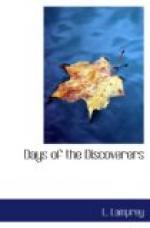He discovered presently that he was of little use to them, for though he could have cut wood or carried water, this was squaws’ work, and should a man be seen doing it every tradition of the tribe would be upset. He was of no use as a hunter, for he had not the hawk-like sight of an Indian or the Indian instinct for following a trail. He could dig out the wild roots they ate, which grew among canes and under water, but this was laborious and painful work, which made his hands bleed. With tools, or even metal with which to make them, he might have made himself the most useful member of the tribe, but as it was, he was even poorer than the wretched people among whom he lived, for they knew how to make the most of what was in the country, and he had no such training.
The lonely Spaniard studied their language and customs diligently. He found that they made knives and arrows of shell, and clothing of woven fibers of grass and leaves, and deerskin. They went from one part of the country to another according to the food supply. In prickly pear time they went into the cactus region to gather the fruit, on which they mainly lived during the season. When pinon nuts were ripe they went into the mountains and gathered these, threshing them out of the cones to be eaten fresh, roasted, or ground into flour for cakes baked on flat stones. They had no dishes except baskets and gourd-rinds, and their houses were tent-poles covered with hides. When a squaw wished to roast a piece of meat she thrust a sharp stick through it. When she wished to boil it she filled a large calabash-rind with water, put in it the materials of her stew, and threw stones into the fire to heat. When very hot these stones were raked out with a loop of twisted green reed or willow-shoots and put into the water. When enough had been put in to make the water boil, it was kept boiling by changing the cooled stones for hotter ones until the meat was cooked.
Many of the baskets made by the squaws were curiously decorated, and made of fine reed or fiber sewed in coils with very fine grass-thread, so that they were both light and strong. There were cone-shaped carrying-baskets borne on the back with a loop passed around the forehead; in these the squaws carried grain, fruit, nuts or occasionally babies. There were baskets for sifting grain and meal, and a sort of flask that would hold water. The materials were gathered from mountains, valleys and plains over a range of hundreds of miles—grasses here, bark fiber there, dyes in another place, maguey leaves in another, and for black figures in decoration the seed-pods called “cat’s claws” or the stems of maiden-hair fern. A design was not copied exactly, but each worker made the pattern in the same general form and sometimes improved on it. There was a banded pattern in a diamond-shaped criss-cross almost exactly like the shaded markings on a rattlesnake-skin. The Indians believed in a goddess or Snake-Mother,




